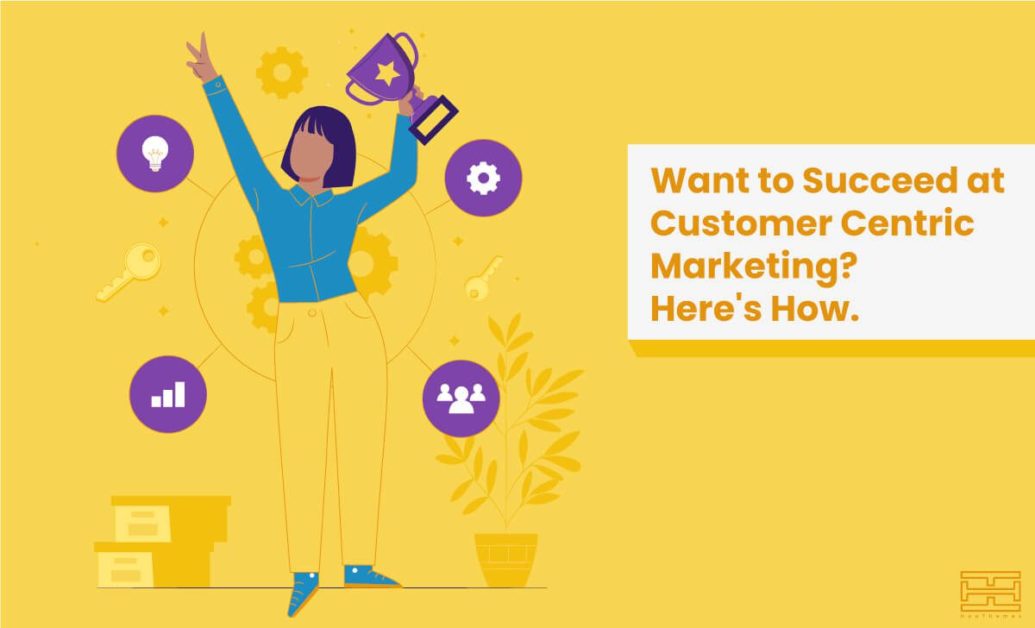The marketing world has evolved to the point that there is no scarcity in the strategies that bring success. Various approaches work out fine. However, this does not make things easier because there comes another complication with it. You need to test out different strategies to see which one fits your situation the best. Customer-centric marketing is one of these approaches.
Customer-centric marketing has been around for a while. Recently, it has gained a massive focus, which brings us to writing this article. Here, we will discuss it in detail and provide you with its best practices.
What is customer centric marketing?
Customer-centric marketing, also known as customer-oriented marketing, is a marketing approach with customer needs and interests in mind. Prioritization of customers over any other factor is a must here. You can use a mixture of intuition, common sense, and reliable data about customer behavior.
A customer-centric approach is based on four pillars:
1. Influencers
Creating relationships with leading influencers in the industry is the first step in today’s world. Your potential customers trust, listen to and learn from these people.
When you associate yourself with these people, you increase your online presence, visibility, and credibility.
2. Content
Modern purchasers who actively seek knowledge try to find their solutions. As a result, sellers and marketers have faced a big problem. That is, older approaches do not work out anymore. Buyers do not get mesmerized by cold outreaches and traditional marketing approaches. Cold call them and cold mail them only to see them ignore you and put you into spam.
As traditional marketing approaches are less effective today, search engines and social networks are gaining more and more power. Digital content now rules the world. It is critical to align content with different customer journey stages and buyer personas. The type of content that engages people will vary based on their characteristics. This is why psychographic segmentation is an essential part of customer-centric marketing.
Furthermore, it would be best to create content that includes story-telling and feels humanly. How-to videos, instructional webinars and podcasts, ebooks, and infographics are good examples of creative content.
One of the valuable customer-centricity examples would be HubSpot. Providing many different types of creative content has helped them be more customer-centric. They offer educational videos and webinars, courses, ebooks, flyer templates, etc.
The format you choose is dependant on your persona mapping. After creating content, you should curate it and share relevant third-party content in it. You do this to fill in the gaps of knowledge of your audience. Then, you need to find the channels your target audience exists and put your content there. It is not ideal to share your content on Twitter where most of your audience is on Instagram, is it?
3. Community
In today’s customer centric marketing, ecosystems and partnerships are critical.
You need an online environment where consumers can communicate, and you can engage staff and inform partners. Sharing inspiring success stories, facilitating support forums, and publishing helpful information are critical aspects here.
Lego Ideas, for example, has done a decent job with their community. You can submit your ideas, participate in contests, and share your activities.
The ability to segment your audience is essential in addition to providing beneficial communication. You must categorize it depending on your industry, region, and whether it is B2B or B2C. This helps you create comprehensive customer personas and get a deeper understanding of what your consumers care about and the issues they confront.
Furthermore, you must facilitate, listen, and participate in the dialogues. This enables you to foster your community while also allowing for authenticity, innovation, and greatness. You may improve the continuous efficacy of your marketing plan, establish your brand’s reputation, win your consumers’ confidence, and generate revenue by creating chances to engage customers and build a sense of community!
4. Advocacy
Customer centric marketing does not come without having advocacy in mind. Why? Because your most effective salesmen are not on your payroll. They are your consumers who are eager to speak well about you. Buyers nowadays not only have more options, but they also have a stronger voice. You can use this to your advantage.
The conventional view of customer advocacy is similar to a customer reference program built on accumulating references. These references assist sales staff in increasing your company’s reputation and acquiring additional clients. But what does a customer reference program provide the consumer in exchange for a referral? It’s a one-way street with no advantage or motivation for the client.
The finest advocacy programs look for methods for you and your organization to deliver value to your consumers. If your customers are cited or referred to in the media, speak at events, or win awards, you may publicize their accomplishments via your own social media platforms.
Uber is a brand who knows his way around customer centric marketing. They have provided their customers with a referral plan that enables you to make more money, while advocating for the company.
Clear communication is essential for creating advocacy. You must provide an exceptional customer experience from beginning to finish, including fantastic goods, honest and accurate marketing, and responsible salespeople. This is essential in customer centric marketing.
It is best to design your whole process to promote advocacy to convert a prospective consumer into an actual advocate. Advocacy is not done at random or by luck. It’s all about people and the connections you build. You must create experiences that elicit emotion. Advocacy is a two-way street that must be earned. Be an advocate for your consumers so that they will want to be an advocate for you.
The main priorities of customer centric marketing strategy
Here, the product is not the primary focal point. This approach begins with the customers’ expectations, requirements, and wishes.
Furthermore, a customer driven marketing strategy is not only about sales channels. It includes corporate culture, process, and philosophy as one unit. A successful customer centric strategy requires a deep knowledge of the reason customers need your products. You are not aiming toward your business growth but toward improving the quality of your customers’ lives. This is what drives your business’s growth.
Three elements are the main priorities for a customer driven marketing strategy:
1. Customer success
Customer centric marketing is all about giving your consumers power and assisting them in being their best selves—even if they don’t wind up buying your product. Think of the following scenario as one of the examples of customer centric marketing.
You can create a network for customer success experts to help them expand their skills and expertise. Then, establish yourself as the go-to firm for customer success information by participating in the community.
As a result, you will become a market leader. Rather than devoting all of your time and energy to preaching about your company’s advantages, your marketing staff will work to promote the interests of the customer success industry as a whole.
2. Long term strategy
Many marketing firms are only judged by the number of quality leads they generate and drive into the sales funnel. This may result in specific quick-fix solutions to get clients in the door, but these strategies are often short-sighted. They may link your sales staff with a client, but they do not establish a long-term connection.
Customer centric marketing executives forego these quick victories in favor of building long-term value.
A limited concentration on leads (to the detriment of everything else) generates marketing strategies nobody loves. Those approaches undermine your brand’s credibility and leave you with more opponents than supporters, which isn’t suitable for your long-term success.
3. Customer advocacy
Customer advocacy is essential for customer centric businesses. They work hard to understand what their consumers really want from their connection, and they advocate for them both within and publicly.
This might imply offering more valuable materials to assist them in becoming better at their employment, or it could imply sharing a customer’s achievement on social media to help spread the word.
Main elements of customer centric marketing
Customer driven marketing covers all areas of a company, from management to each department of the company. Marketing, sales, and even service staff are engaged when it comes to this approach. Additionally, customer centric marketing provides a multichannel strategy that allows customers to reach out to the company through any channel.
A customer centric marketing approach is made up of four main elements:
1. Customer empowerment
Not only is the customer king, but also they are significant influencers. If a consumer has a good experience with a firm, they may endorse it on social media. Perhaps they will give the product a rating or review to indicate to other consumers that they are pleased with it. And customers utilize this feedback to make purchasing choices.
Customers also use forums and communities to learn about goods and businesses, resulting in a well-founded initial impression. This trend is best described by the phrase “Customer Empowerment.” Customers are more than simply product purchasers; they also decide a company’s success or failure. As a result, the client can impact the company’s destiny.
2. Customer centric company
Customer empowerment is only achievable if the organization creates a good atmosphere. The primary purpose of customer centricity is to make product purchases pleasant. Appropriate technological solutions are therefore required.
A significant side effect is that organizations differentiate themselves from competitors by concentrating on the consumer and presenting themselves as market advocates pursuing their own plans.
When the customer journey and experience are unique, you can also interpret customer centric marketing as a Unique Selling Point (USP). All measures taken by all personnel of the firm must be oriented toward the customer.
3. Customer centricity at the point of sale
One of the benefits of customer-centric marketing is the positive shopping experience. This may also happen at the point of sale. You can use ‘Loyalty Programs.’ Customers want to feel at ease, be addressed personally, and believe that the firm is trustworthy and reputable. Tailor-made items and product bundles are one approach to fulfill the demands of customers.
In the retail industry, you can accomplish this with a personal approach and a trustworthy look. Customers entering a big coffee shop chain, for example, are greeted by their first names as they enter the business and buy coffee.
Customer-centric e-commerce involves a variety of variables, such as user-centered design, a high degree of usability, inbound marketing, and a multichannel strategy.
4. Customer centricity and post-sale
Post-sale is of significant importance in customer centric marketing. Customers’ interactions with a firm can influence their subsequent purchasing habits. Long-term efforts become visible after the sale. How does a business handle clients who have previously bought products?
It is a well-known truth that it requires less expenditure to retain existing consumers than to acquire new ones. This is why customer centric marketing is about more than just first-time purchases; it is also about long-term customer connections that might potentially span a customer’s whole life.
Why is customer centric marketing important?
When a firm adopts customer centric marketing, it alters its fundamental philosophy, which influences online operations and other marketing sectors. At best, the company culture as a whole evolves. This opens up new opportunities for online marketing. All processes begin with an examination of the clients and their requirements. Online surveys, client feedback, or an expert opinion from a blogger may provide significant insight for online marketing while also increasing contact with the organization.
This method, when used with inbound marketing, has the potential to have synergistic results. If content marketing teams incorporate client desires, they can produce many leads that would not have been achievable with other marketing strategies. Companies that constantly seek customer-centric marketing report considerably greater performance levels (as shown in research done by Deloitte and Touche, 60% more profitability) when compared to companies that use typical marketing strategies. That’s because this strategy and inbound marketing anticipate consumers’ demands and provide them with more specialized answers. In general, the size of the organization has little bearing on efficient client centricity.
How do you develop a customer-centric marketing strategy?
Customer-centric marketing requires deliberate action; the transformation does not occur by chance. Here are some strategies to refocus your marketing on your consumers:
1. Start with senior leadership.
A change in corporate strategy is always more successful if people at the top of the organization support it. Teams that are motivated by their leaders will flourish in an atmosphere where everyone feels heard and encouraged. They will, in turn, “manage the client experience with the same amount of care and compassion.”
“Centeredness” is an important quality necessary for inspiring leadership. It is a state of mind that allows leaders to stay calm in stressful situations, empathize, listen fully, and be present.
All of these characteristics are also necessary for customer-centric marketing. While leaders model these traits internally, staff are more likely to emulate them when dealing with consumers.
You can see what consumers are saying if you stay in touch with them via support. You have the chance to contribute to issue-solving via business choices, product enhancements, and design.
Even if your senior staff isn’t entirely on board at first, get them closer to the consumer by providing chances to communicate directly with users and share customer quotations. You may get them closer to the eventual objective of complete support by establishing relationships and demonstrating the effectiveness of customer centric marketing.
2. Get to know your customers.
To be successful with customer-centric marketing, it should go without saying that you must spend time getting to know your consumers well. There are several methods to do this:
- Interview current or previous clients one-on-one.
- Send out surveys to clients to get general input on a particular set of questions.
- To find out what others are saying about your firm online, use social media monitoring tools like Google Alerts.
- Utilize the data that is accessible in any analytics solutions that your organization subscribes to.
- Spend time reading and replying to consumer emails to assist your support personnel.
- Participate in calls with your sales staff or listen to recordings of their conversations with prospects.
- Getting closer to your clients necessitates getting closer to the individuals that interact with them daily. Front-line personnel, such as customer service and sales, have a plethora of knowledge about what consumers want and ask for.
3. Build infrastructure around the customer
Investing in customer centric marketing will provide the most significant returns. Systems and procedures are the most effective means of scaling customized experiences.
Connecting clients to the resources that are most relevant to them, for example, necessitates personalized messaging based on customer segmentation. Flows for any form of client requirement or job-to-be-done may be created using optimized design.
Customer centric marketing must be hyper-personalized to be successful. Knowing your user personas is an excellent place to start, but you must segregate clients in your systems to communicate with each individual properly.
You may segment your user base in an unlimited number of ways. From the services they use to how active they are in their job titles, the more particular you can be with your marketing plan, the more granular you can be about your consumer base.
Instead of creating tools to achieve company objectives (e.g., persuading customers to sign up), develop tools to achieve customer goals, and the firm’s success will follow.
4. Publish content your customers want and need to read
Customers will view and engage with the material on your brochures, website, blog, and sales presentation. A customer centric marketing team creates material so that it is helpful to customers even if it does not explicitly sell or promote their product.
To build the most helpful content, you can ask the following four questions:
- Who are these customers you’re trying to reach?
- What are their personas?
- What are the other problems that are extremely painful in their lives?
- How can your brand work on solving those problems, whether they have anything to do with your product or not?
5. Collect feedback and iterate
It’s acceptable if you don’t strike the nail on the head straight immediately. Being customer centric in your marketing entails listening, adapting, and responding to changing consumer cues. Assuming you start with a high-quality product and service, being customer centric entails recognizing and respecting the customer’s interests. You troubleshoot issues, address complaints, and consider consumer preferences.
Creating a closed-loop feedback system — one in which you gather, act on, and react to client input — will require you to adjust your marketing plan to be more effective continually.
Tips for succeeding at customer centric marketing
1. See the world from your customer’s POV.
It is critical to see the world through the eyes of your customers, yet this is often easier said than done. After years of working for the same organization, marketing professionals may become myopic about their industry, business, and product. They are well familiar with their industry, but a prospect with little awareness of the brand must be able to determine what your firm does at a look. Otherwise, they’ll go on to the next bright thing.
When your team observes a reduction in leads, they usually throw around a few hypotheses about what’s causing it. They are aware, however, that they are unable to conclude. To comprehend what’s going on, it’s critical to have the correct market information, customer listening strategy, and technologies.
A five-second test may aid your customer centric marketing efforts. A five-second test involves a panel of test subjects seeing a website for just five seconds before it vanishes. Then, in a five-second test, individuals are asked to recollect their initial impressions of the firm and what they remember about it. You can test home page designs, landing pages, logos, brochures, and marketing material with five-second tests.
We might be fooled by our own expertise and significant experience in our field as marketers. To contradict our own preconceptions, we must occasionally step back and utilize input directly from individuals of interest (such as five-second tests, surveys, customer interviews, or even in-page feedback widgets) to discover how our target market perceives our brand.
2. Don’t make your customers angry.
Isn’t this self-evident? Despite this, we are constantly inundated with sleazy marketing practices that drive us insane. One example is a method that everyone who has a mobile phone has encountered. A robocall spoofs an incoming number that nearly matches your own (by barely a digit or two), thinking you’ll pick up because it appears familiar. If you decide to pick up, your encounter with the brand will almost certainly be unfavorable, and the corporation will have created an immediate detractor in you. These strategies result from an overemphasis on short-term KPIs such as lead generation. But wait for a second!
So, which metrics should you prioritize for the long term?
3. Use the insightful long-term metrics to understand your customers.
Data-driven marketing may provide you with valuable information. It’s tough to comprehend your consumers if you don’t have the correct data.
When measuring the public perception of your brand, you must monitor these metrics:
Aided Recall
Aided recall assesses how well individuals remember your brand when given a little assistance. Can they tell you how your TV ad finishes after watching the first half? Do people identify your logo design among a slew of others in your industry?
The aided recall is the number of persons who indicate knowledge of a brand or product.
Unaided Recall
This metric goes one step further, asking, “Does your brand spring to mind without prompting?” “For example, if you operate an e-commerce website and ask someone about prominent online shopping destinations in your industry, do they mention your website?
Sentiment
What is the general opinion of your brand? Based on news reports and their personal experiences, do they regard you in a good, neutral, or negative light?
You may get the voice of the customer (VOC) data through surveys that ask specific questions about their thoughts about your brand and evaluate the open-ended responses. Still, you can also obtain data from customer reviews. How exactly does it work? Services such as Amazon Comprehend use Natural Language Processing (NLP) algorithms to mine qualitative data for keywords that signal customer happiness (or lack thereof).
Net Promoter Score (NPS)
Do they think you’re fantastic? They will purchase your goods, but will they also promote you to their coworkers, friends, and loved ones? Net Promoter Score assesses a customer’s propensity to suggest your brand to others. But why is calculating your NPS so critical?
When customers become promoters, it shows a degree of dedication to your company beyond simple consumer happiness. They’ve become an evangelist for your company, and personal referrals are an effective method to acquire new customers.
4. Give your customers a fantastic experience.
We, as marketers, spend a lot of time talking about how to improve conversions from one stage of the funnel to the next, but what about the broader picture? Do our clients really like us? Are we providing a positive experience for them at every point of the sales funnel, from awareness through repeat purchases?
Three ways to improve customer centric marketing efforts
There are many ways you can approach customer centric marketing. Here we will provide you with the most effective ones.
1. Website usability
Is your website simple to navigate? Is the experience you provide helpful, relevant, and even safe? Using a website tracking tool such as WatchThemLive to examine what visitors like and dislike about your website and find flaws is one technique to assess its usability.
It may be simple to you where they should go to modify their mailing address or credit card information, but it may not be evident to them. Even if your viewers convert, they will be irritated if they have to look around for information. All of these minor interactions add together to form your brand. Every micro-experience someone has with you adds up to become your brand.
When it comes to heatmaps, listening, and knowing your consumers and where they’re going, WatchThemLive is the go-to solution. The recordings are just priceless. The bottom line, of course, is that you must provide a flawless online experience if you want to convert consumers into promoters.
2. Content marketing
When your prospects and customers interact with your brand via relevant, engaging content that enhances their lives in some meaningful manner, they will have a more excellent relationship with it.
When the emphasis is on producing high-quality content, podcasts, vlogs, and blogs can all help you achieve this effect (rather than overt advertising trying to pass for content marketing). Also, do keep a sharper eye on content theft. And have a plan in place to deal with it effectively. This MentorDial case study should prepare you to make countermoves when someone copies your content.
The trick to outstanding content marketing is to keep the brand in the background while focusing on fascinating themes related to the company’s objective.
3. Customer support
Too many businesses take shortcuts on customer service to spend as little money as possible—and they get what they pay for! This is an essential element of customers’ brand experience, and poor customer service will leave a bad taste in their mouths. There are, fortunately, a few crucial things you can do to enhance that experience.
It is critical to make customer service accessible to everyone on the planet. So, if you have clients in Pakistan, don’t restrict your service hours to 9 a.m. to 5 p.m. PST. You want to be there for people no matter where they are. As a result, managing customers across different time zones is critical. It is also critical to provide help across several channels, such as phone, chat, email, social media, etc.
Finally, a customer centric marketing strategy combines intuition and common sense with reliable facts regarding client behavior. Consider the brand experiences that have made you become an advocate for a particular firm, and try to replicate those approaches. Resist fast and simple marketing methods (even if they create easy leads or conversions), evaluate your assumptions with useful, long-term analytics, and strive to deliver actual value every time a prospect or customer engages with your business.
Conclusion
After discussing customer centric marketing in depth, it is best if we give you the most important takeaways. First of all, assume nothing. Instead, collect real data to get to know your customers on a deeper level.
Then, use the long-term metrics to learn how your visitors and customers experience your brand. After, apply marketing approaches that offer real value. Try to delight your viewers at every point in your sales funnel. Set the bar higher! You want to create promoters—not just customers who pay.
I hope that this article helps you refine your customer-centric marketing and escalate your business with it






![Read more about the article Sponsored by Adidas [in 2023]: The Ultimate Guide to Choosing the Perfect Running Shoes](https://www.hoothemes.com/wp-content/uploads/2023/04/Hoothemes-2-300x157.png)


